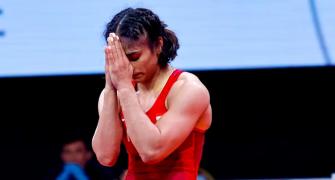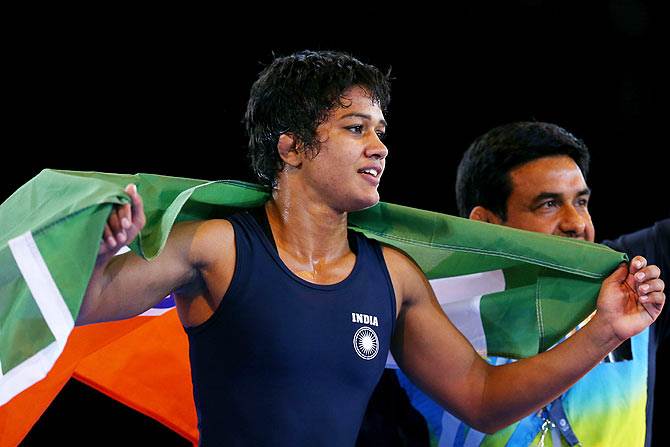Indian wrestler Vinesh Phogat was disqualified before the women's 50kg freestyle final at the Paris Olympics on Wednesday after weighing in 100 grams heavier than her weight category allowed.
Phogat, whose natural body weight is around 55-56 kg, took drastic measures to compete in the 50kg category, the chief medical officer of the Indian delegation in Paris said.
One of her teammates told Reuters she had practically starved herself for a week to make the weight, in addition to taking drastic measures to lose more weight, including extreme restrictions on her water intake.
Phogat would have preferred to compete in her favourite 53kg event but while she was injured compatriot Antim Panghal claimed the quota in that class.
Phogat could have either moved up a class, which would have seen her wrestle larger opponents, or move further down to 50kg, which was risky since she had to shed up to six kgs.
Here are the key aspects of the weight-loss practices undertaken by athletes in some sports prior to competition:
WHAT ARE WEIGHT CATEGORY SPORTS?
The weight category sports at the Olympics are wrestling, boxing, taekwondo, judo and weightlifting.
Most of these are combat sports and weight categories are designed to match athletes with competitors of similar size.
In wrestling at the Paris Olympics, there are six weight categories for women and 12 for men.
Under international rules, weigh-ins are organised each morning for each weight category.
During the weigh-in process, wrestlers have the right to get on the scales as many times as they wish.
Referees check that all wrestlers are at the weight corresponding to the category they are competing in.
If an athlete does not attend or fails the weigh-in, he or she will be disqualified.

WHAT METHODS DO ATHLETES USE TO MAKE WEIGHT?
Cutting weight is a widespread practice in Olympic wrestling and in other sports with weight categories.
Some athletes opt to compete in a category below their natural weight to fight a weaker opponent.
Athletes tend to restrict their food and fluid intake before weigh-ins and combine that with activities that induce sweating such as training or using a sauna.
"The process of weight cut prior to the weigh-in in the morning involves a calculated restriction of food and water," said Dinshaw Paudiwala, chief medical officer of the India delegation.
"Besides this, the athlete needs to sweat, and that sweating is done with sauna and with exercise."
Restricting fluid and food intake leads to weakness, which is counterproductive to high-level athletic performance. After weigh-ins, athletes will consume high-energy foods to restore their bodies and prepare them for competition.
Phogat had to consume water before her three bouts on Tuesday to prevent dehydration but her weight increased more than planned, causing her team to take extreme measures overnight.
"We had tried all possible drastic measures throughout the night, including cutting off her hair, shortening her clothes but despite all of this we could not make it," Paudiwala said after Wednesday's disqualification.
Vinesh was later administered intravenous fluids.
WHAT ARE THE RISKS INVOLVED IN WEIGHT CUTTING?
Some of the methods athletes use to drop weight rapidly can put them at risk.
Doctors have warned against resorting to vomiting, laxatives, diet pills or extreme restrictions of fluid and food intake to drop weight. All diuretics and masking agents are banned by the World Anti-Doping Agency (WADA).
In guidelines published in 2022, the Australian Institute of Sport said that hormonal variations throughout women's menstrual cycles influenced several aspects of weight management and should be taken into consideration during weight cutting for female athletes.
"Recommended body fat cut-off limits are higher for females and they appear to be more vulnerable to adverse health and performance implications of sustained periods of dietary restriction and/or training excesses," the guidelines said.
The risks to athletes engaging in this practice included eating disorders, poor bone density and hormonal imbalances.
HAVE ATHLETES DIED TRYING TO MAKE WEIGHT FOR COMPETITION?
There have been several cases in which athletes have died from the effects of a weight cut in both Olympic and non-Olympic disciplines.
In 2015, Yang Jian Bing, a flyweight from China competing in MMA (mixed martial arts), died at 21 after suffering complications following a weight cut.
Wrestler Jeff Reese of the University of Michigan died in 1997 of kidney failure and a heart malfunction while wearing a rubber suit and riding a stationary bike to lose weight.
A string of similar deaths caused the United States' National Collegiate Athletics Association (NCAA) to change weight-loss rules for collegiate athletes.









